Vegetarian Japchae (Korean Glass Noodles)
This post may contain affiliate links. Please read my disclosure policy.
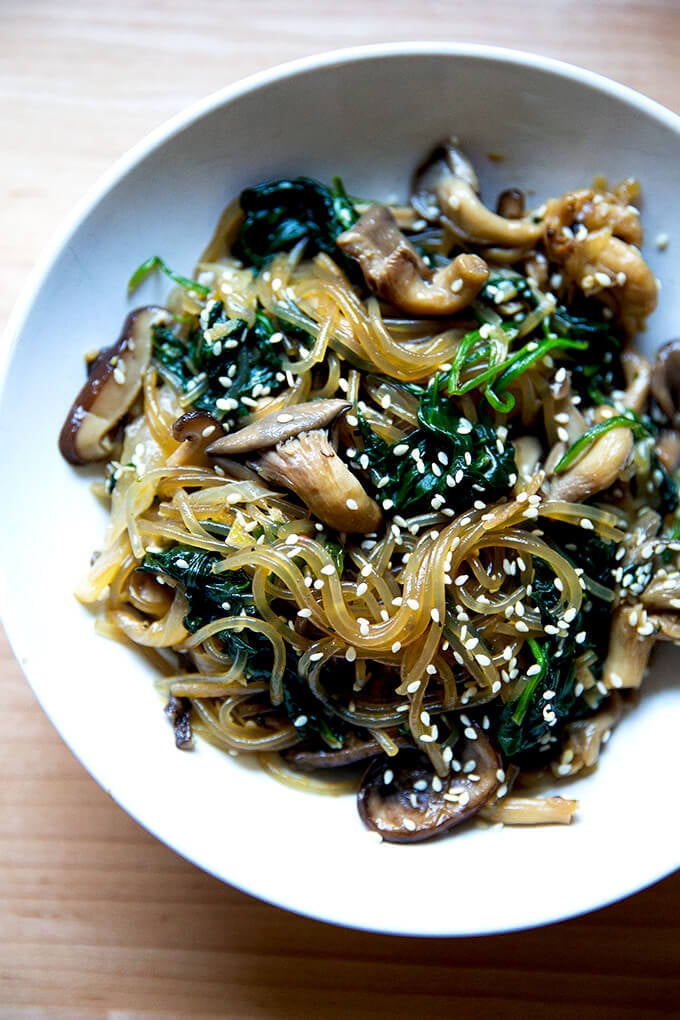
If you love Korean food, you no doubt know japchae, the dish made with those glassy, translucent noodles, tangled with lots of vegetables, mushrooms, and meat. Along with kimchi and bulgogi, it’s one of the most well-known Korean dishes, one I look forward to anytime I find myself in a Korean restaurant.
Until about a month ago, I never would have considered making japchae at home. It seemed too exotic, an endeavor that would require a trip to the Asian market, only to potentially return with the wrong ingredients (or the right ones, only to mess it up anyway).
What I’ve learned recently, however, thanks to Maangchi’s Big Book of Korean Cooking, is that there’s nothing exotic about japchae’s makeup: it’s noodles + veg & meat + sauce. I did have to make a trip to the Asian market for the noodles, but I had all of the other seasonings on hand: soy sauce, sesame oil, brown sugar, garlic, and sesame seeds.
And guess what? Making Japchae, Maangchi’s way at least, is incredibly easy.
Maangchi’s Japchae
As noted above, to make japchae, the only ingredient you’ll need to seek out are the dangmyeon noodles, which are made from sweet potato starch (making them gluten-free). Your local Asian market likely will carry them, or you can order them online.
Some recipes call for boiling dangmyeon, but here, you’ll simply soak them in cold water for 40 minutes, during which time, you’ll prep everything else.
Typically, Japchae is made stir-fry style. Maangchi herself previously called for stir-frying, both in her first book and on her YouTube channel.
But in her new book, she simplifies the process, employing a completely different method — it’s almost like an un-stir fry. Rather than sauté the vegetables one by one in an uncovered hot pan, she layers everything into a cold pan: first the onions, carrots, mushrooms, and scallions, then the spinach, then the noodles, and finally the sauce.
Once the layering is complete, she covers the pan, and sets it on the stovetop over medium-high heat. Ten minutes later, she uncovers the pot, sprinkles in some sesame seeds and sesame oil, gives it a stir, and calls it done!
It’s incredibly easy, and incredibly tasty, and whether you know the dish or not, I think you’ll love it.
PS: You can read more about Maanghi’s latest cookbook and four others over here, where I’m giving away a copy of it as part of my annual cookbook chat with Margaret Roach.
Here’s the play-by-play: Find yourself some dangmyeon (sweet potato starch noodles). Your local Asian market should carry them.
Soak the noodles in cold water for 40 minutes.
Slice up some mushrooms, garlic, and onions; slice scallions into 2-inch lengths:
Thinly slice carrots: You can do this with a mandoline (left) or knife (right).
Stir together a simple sauce: soy sauce, garlic, brown sugar, and pepper:
Place the mushrooms, scallions, onions, and carrots in a wide, heavy-bottomed pot: I love my 5-qt Le Creuset braiser for this.
Toss vegetables with 1/4 cup oil and 1/4 cup water:
Top with a half pound of spinach:
Cut the soaked, drained sweet potato noodles into 6-inch (roughly) lengths:
Place on top of spinach and drizzle sauce over top:
Place pan on the stovetop, cover, and cook over medium-high heat for 10 minutes:
Open the lid, and give it a stir:
Add sesame seeds and sesame oil:
Toss!
Serve!
Maangchi’s Big Book of Korean Cooking:
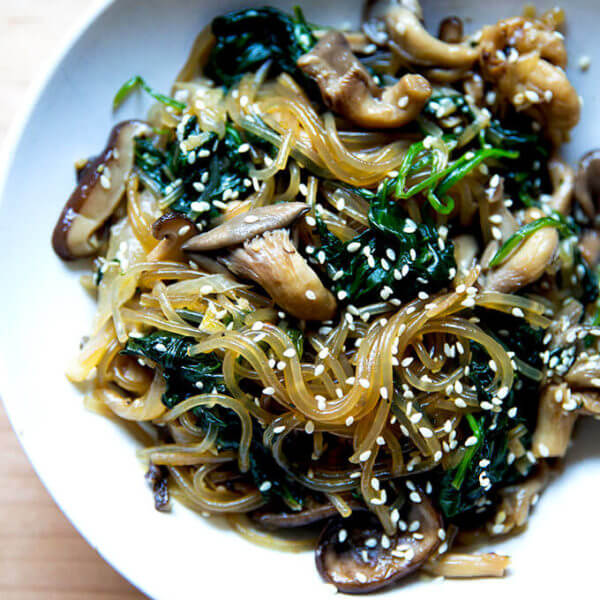
Vegetarian Japchae (Korean Glass Noodles)
- Total Time: 50 minutes
- Yield: Serves 4
Description
Japchae is a Korean dish made from dangmyeon noodles (sweet potato starch noodles) which are also known as “glass noodles” for their translucent appearance.
The recipe below is a vegetarian (vegan actually) version of the recipe in Maangchi’s Big Book of Korean Cooking. I’ve not only omitted the meat, but also the wood-ear mushrooms, because Maangchi listed them as optional. Know that you can adapt this recipe in countless ways: with meat or without, with mushrooms or without, with any number of vegetables you like.
The only hard-to-find ingredient here is the dangmyeon. I found a very reasonably priced large bag at the Asian market in Albany, and I would imagine most Asian grocery stores would carrying them. You can also order online: Dangmyeon (Sweet Potato Starch) Noodles.
I have
Carrots: I like to use my mandoline for this, but a knife works just as well.
Mushrooms: A mix of mushrooms is nice: shiitake, oyster, maitake, enoki, crimini.
Ingredients
- 8 ounces sweet potato starch noodles (dangmyeon), see notes above
- 2 tablespoons brown sugar
- 1/4 cup soy sauce
- 3 – 5 cloves garlic minced
- fresh cracked pepper to taste
- 12 – 16 ounces mushrooms, thinly sliced, see notes above
- 1 large onion, sliced
- 1 to 2 large carrots, peeled and thinly sliced, see notes above
- 4 to 6 scallions cut into 2.5-inch pieces
- 1/4 cup olive oil
- kosher salt to taste
- 8 ounces baby spinach
- 1 tablespoon sesame seeds
- 1 tablespoon sesame oil
- hot sauce, such as Sriracha, if you wish
Instructions
- Place the noodles in a large bowl (I use a large pot) and cover with cold water. You may need to weigh the noodles down with a lid. Let stand for 40 minutes.
- Make the sauce: In a small bowl, stir together the brown sugar, soy sauce, garlic, and pepper.
- Assemble the japchae: In a large, wide heavy pot or sauté pan (I use my 5-qt Le Creuset braiser for this), combine the mushrooms, onion, carrot, and scallions. Season with a good pinch of kosher salt. Add the olive oil and 1/4 cup water, and toss with your hands to combine. Pile the spinach on top.
- Drain the noodles and, using scissors, cut them into 5- to 6-inch lengths. Place the noodles over the spinach. Give the sauce a stir and drizzle evenly over top.
- Cover the pan and set it on the stovetop. Turn heat to medium-high and cook for 10 minutes. Uncover and give everything a stir.
- Finish the dish: Add the sesame seeds and sesame oil and stir to combine. Serve immediately with hot sauce on the side if you wish.
- Prep Time: 40 minutes
- Cook Time: 10 minutes
- Category: Dinner
- Method: Stovetop
- Cuisine: Korean
This post may contain affiliate links. Please read my disclosure policy.

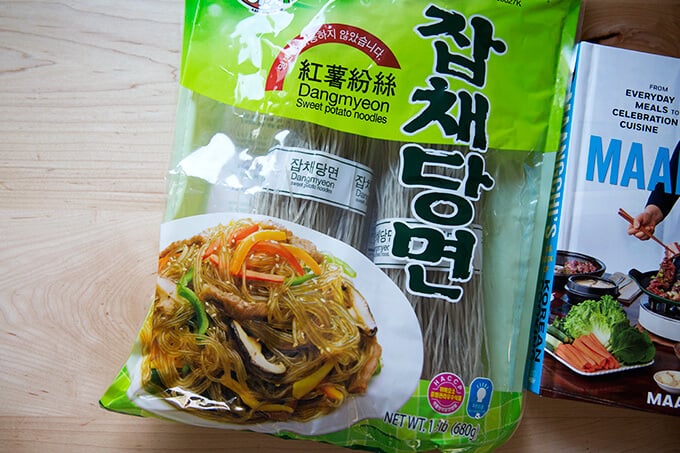
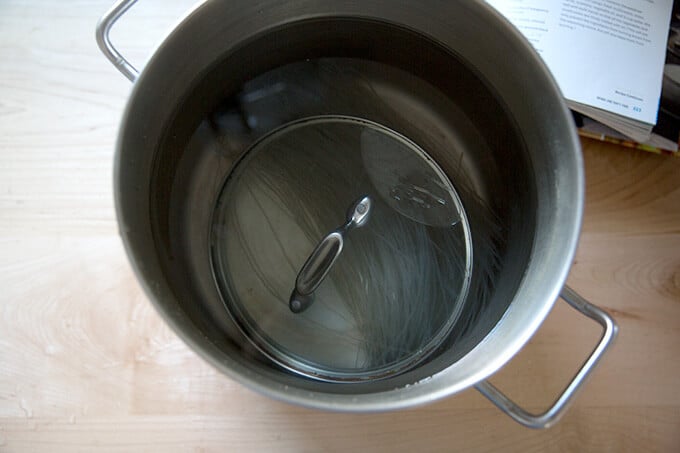
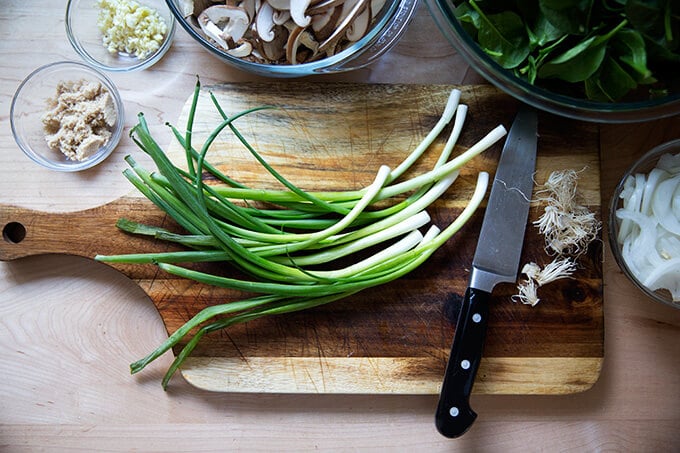
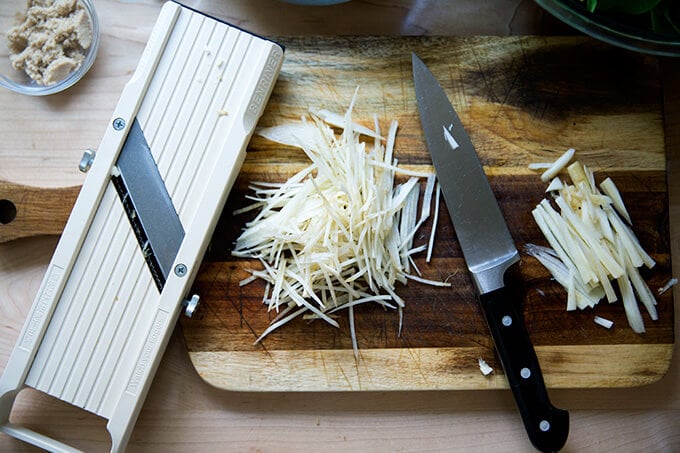
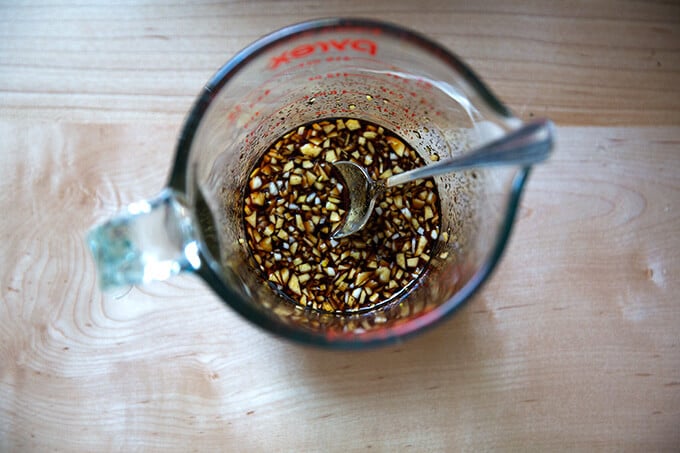
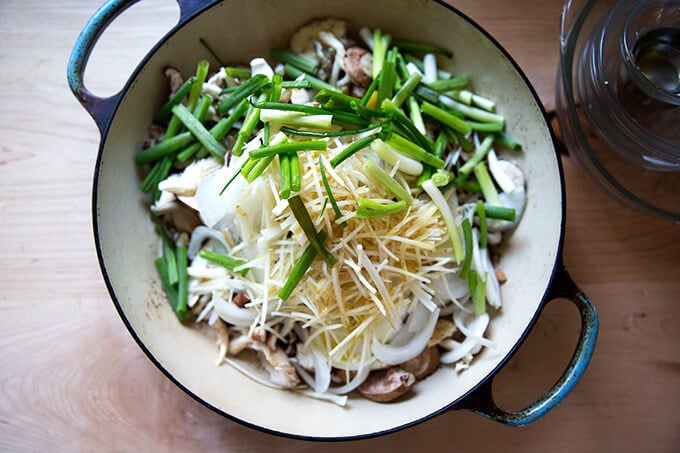
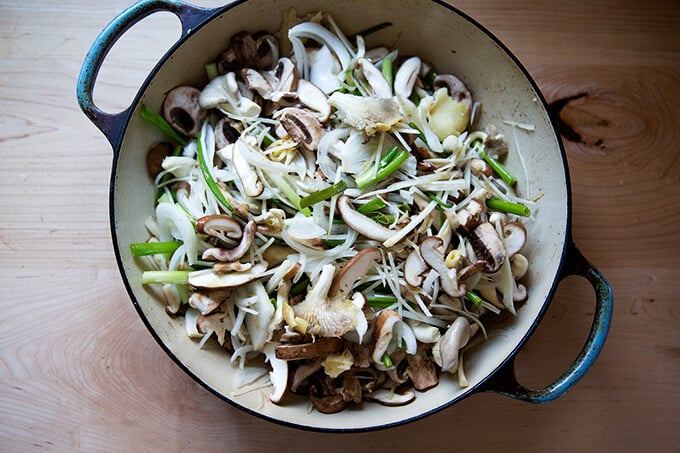
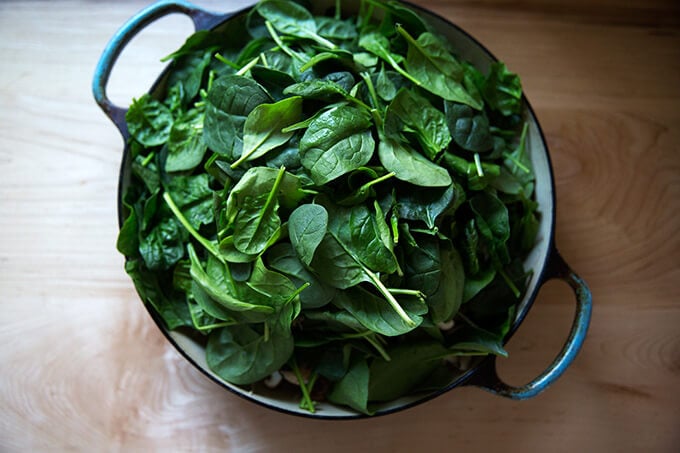
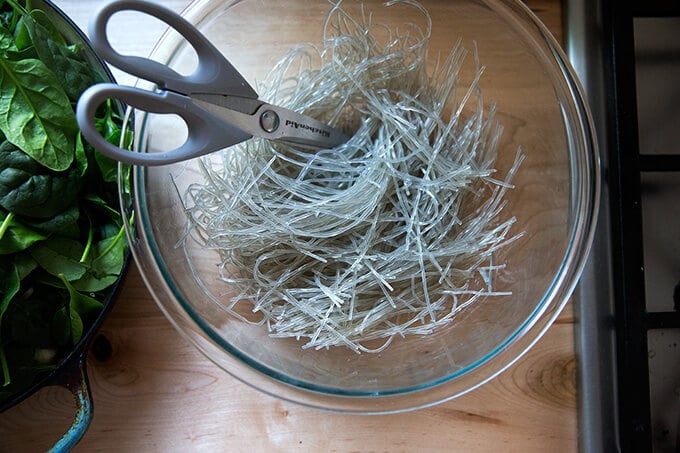
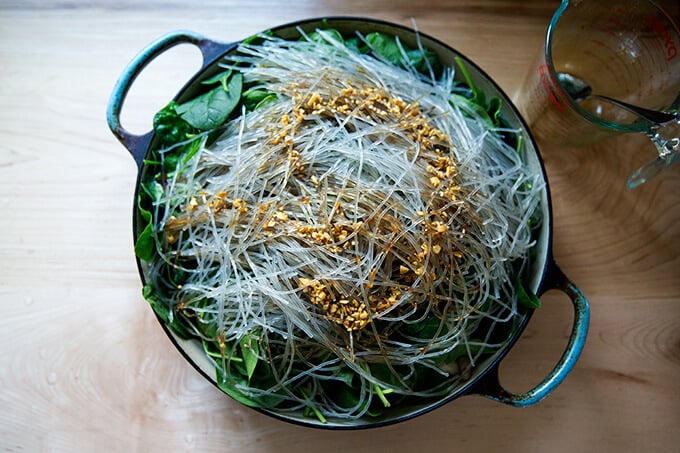
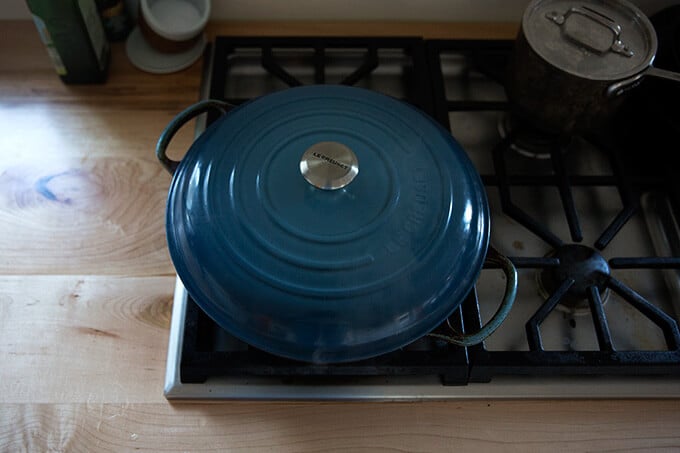
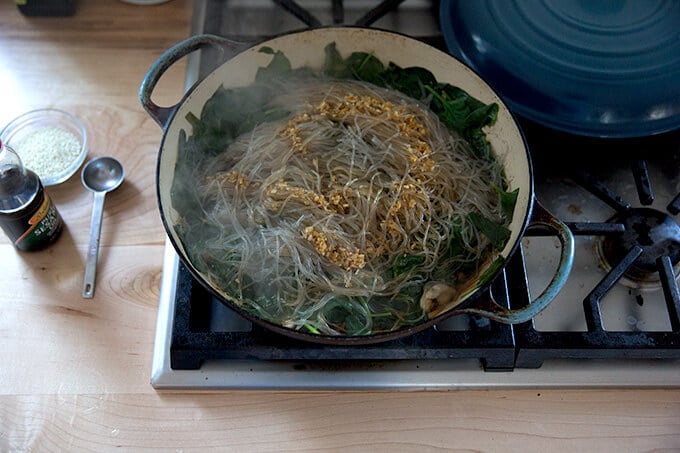
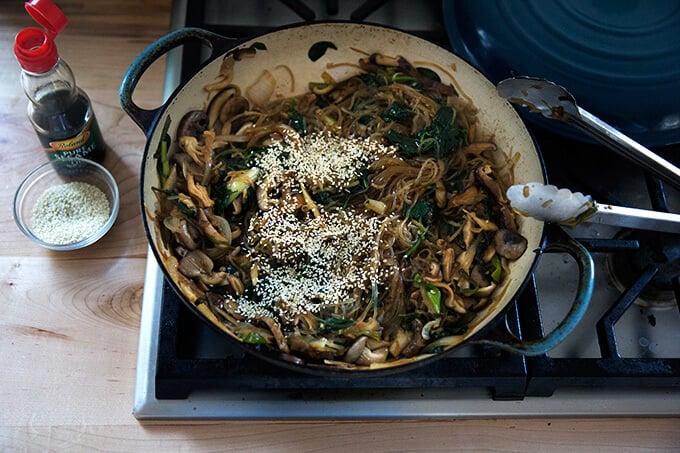
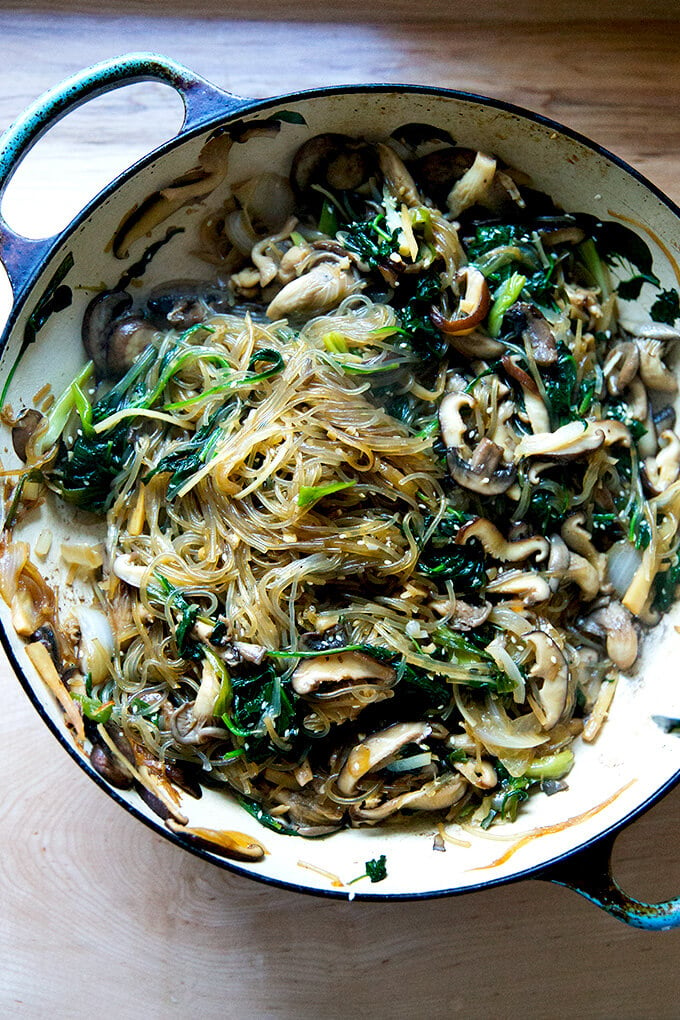
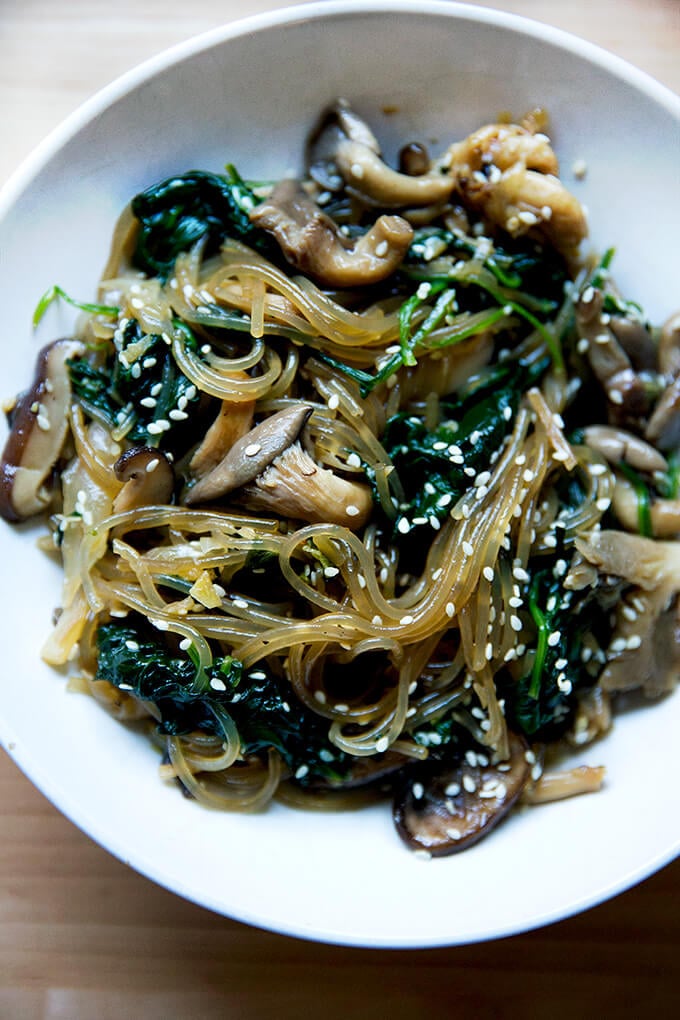
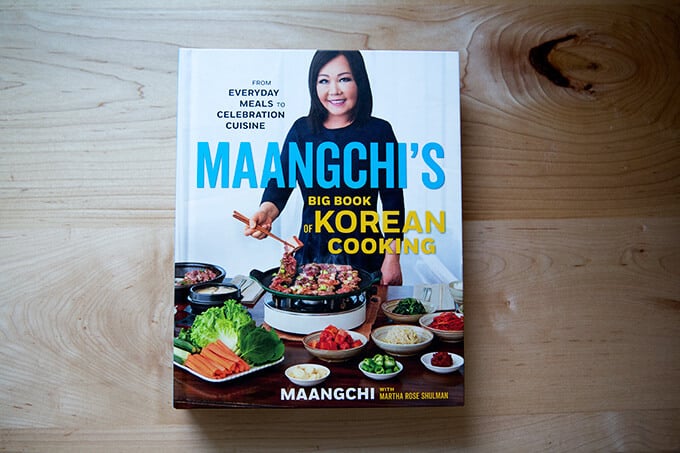
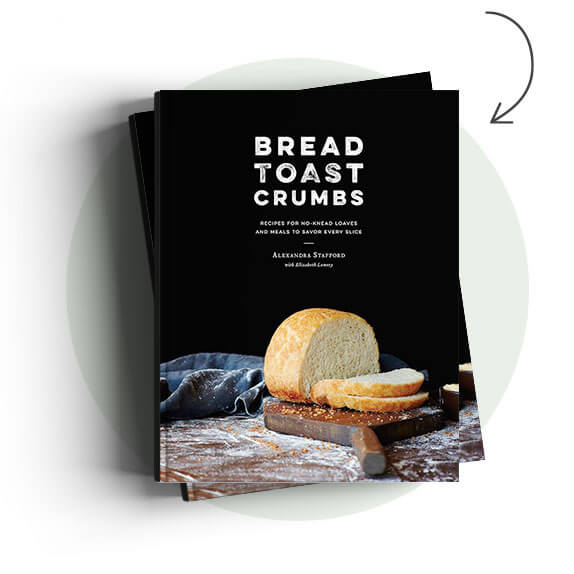

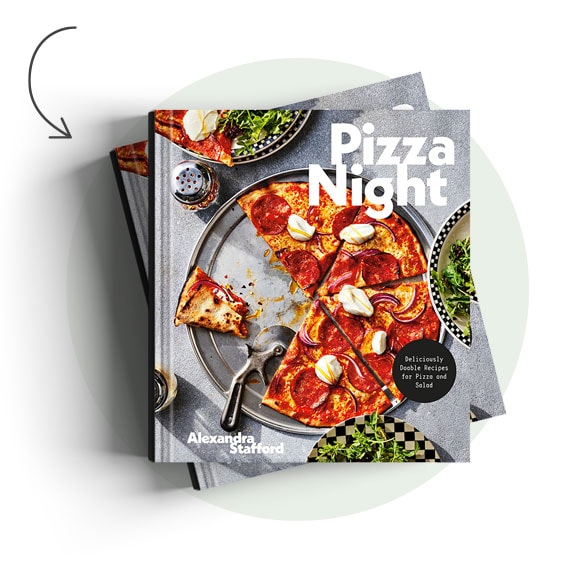
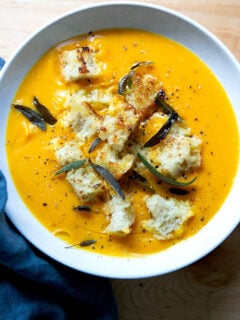

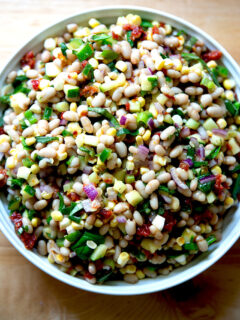
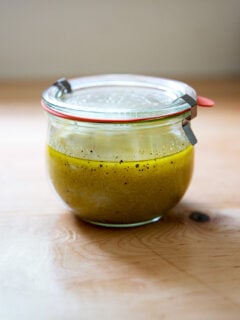
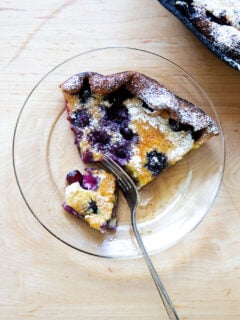
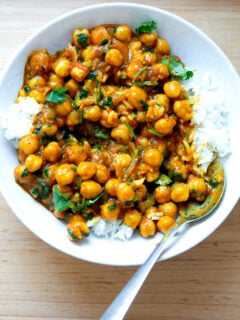

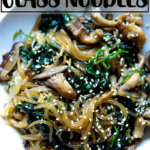
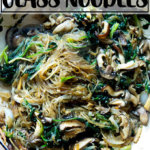
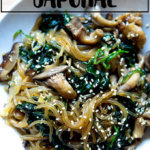
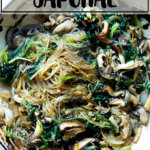
35 Comments on “Vegetarian Japchae (Korean Glass Noodles)”
I love this! I love love love Korean cuisine. This recipe and dish is fabulous. I can’t wait to cook through Maangchi’s book.
It’s so good, Dana!
Where is the acid in this recipe.
Soy sauce
After listening to Ali and Margaret talk about this dish on the Away to Garden podcast, I went right out to get the noodles. It was so easy and tasty. I ended up cooking it about 4 minutes longer to get the noodles to the right texture, but I think that might have been needed because I shorted the soaking time a little. I find myself wondering if I could use this same method with spaghetti or linguini, adjusting some of the timing. I have in mind cherry tomatoes, shrimp, spinach…what do you think?
So happy to hear this, Anne! I love your spaghetti or linguini idea, and tomatoes, shrimp, and spinach sound amazing. I think it will just be a matter of trial and error to get the timing right or being vigilant to ensure you don’t overcook the pasta. Let me know if you give it a go!
This is so much fun to make and makes one feel like an accomplished Korean cook! It is such an easy dish to make, and yet its flavors are complex, and it is beautiful to behold. I used avocado oil, which I thought might be a bit more neutral than olive oil and yet impart a nice flavor. The ingredients are readily available although I ordered my noodles from Amazon. They arrived in a padded envelope, which I expected to reveal a pile of crushed noodles, but they are incredibly hardy when dry–not a broken noodle in the package. Sriracha is a nice addition, but for those without a liking for hot food will find the noodles delectable as is. Perfect directions! I used a 13 inch all-clad braiser–the ingredients were piled high, above the rim actually, but the lid is domed, and everything collapses when steaming. A great success and such a treat for a weeknight meal.
So happy to hear this.
This dish is delicious- such wonderful flavors and so easy!
So happy to hear this, Diane! Great to hear from you 🙂 Merry Merry Christmas and Happy New Year xoxo
Tastes just like traditional japchae, but is so much quicker and easier to make. I made this for a staff lunch and my colleagues were fighting each other for seconds!
Yay! Lee, I’m so happy to hear this 🙂 🙂 🙂
Super delicious and easy! I had mine with some kimchi!
Yay!! So happy to hear this 🙂 🙂 🙂
Yum! I only have rice noodles on hand. Would that work? Thank you!
I think so, but I would probably just cook them as directed on the package, and add them at the end… so, in other words, leave them out of the 10-minute stovetop cooking part.
If I want to add shrimp, when will I do that, and should I cook them first?
Thanks very much. Can’t wait to try this.
In the original recipe, Maangchi sautées beef first, then removes them from the pan, so I would do that: sauté the shrimp first, erring on the side of undercooking them. Then add them back in at the very end. They’ll continue to cook once tossed with the hot noodles and vegetables.
This recipe is some type of wizardry! I was skeptical at first because my noodles were still somewhat stiff after 40 minutes of soaking. But I layered everything in as directed, covered the pot, turned the stove on and 11 minutes later I had a beautiful and delicious dish. I added an additional 1/4 cup water because my package of noodles was 10 oz. This will no doubt be put into regular rotation. Thanks, Ali, for another delicious and reliable recipe!
So happy to hear this, Jackie! Smart to add extra water 🙂
This was great…and easy. Used bok choy instead of spinach since it looked good at my Asian Market when I picked up the noodles. Sliced the lower half and add to main part…green on top instead of the spinach. Thanks for a fun, new recipe! Love your talks on Away to Garden with Margaret.
So happy to hear this, Sue!
So easy to make (fight any skepticism you may have about the ‘doneness’ of the noodles after soaking!) and turns out beautifully. Can’t believe I ever tried to cook this dish any other way. Thanks for sharing this recipe, definitely going to pick up Maangachi’s book now, too.
So happy to hear this, Julie!!
Fantastic! Made for the second time tonight. Like magic!
So great to hear this, Bea!
Thank you, thank you for streamlining japchae! All of the deliciousness, half the work!!
Also, thanks to Susie for sharing the link with me.
Wonderful to hear this, Amy!
To order ingredients visit SFMart.com
This technique is genius, thank you for posting it! I made it with coconut oil instead of olive oil, cut the sugar a bit, added chili garlic sauce to the dressing, added sliced green bell peppers to increase the quantity and used regular spinach instead of baby spinach. I’ll be making this regularly, switching up the dressings and vegetables to suit what we want and have. Next will be a Vietnamese-ish dressing with fish sauce. My children will be making it next, we’ll need to monitor their cutting with a knife but aside from that this is a perfect dish for children to take on. Thank you!
So great to hear this, Nisha! I love this one so much, and I love the technique …. so easy!
How does this hold up for left overs?
Delicious leftovers!
I was literally shocked it turned out so good. I had a 12 oz pkg of noodles so added a 1/2 cup of water. I also added gochujang to the sauce. Fabulously easy. Next time I may use pure maple syrup instead of brown sugar. I need to avoid cane sugars
Great to hear! Thanks for sharing. I love this one so much.